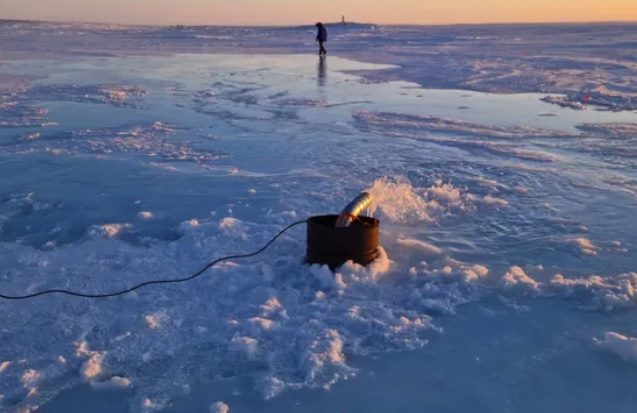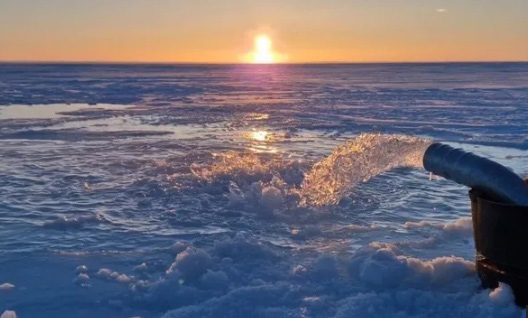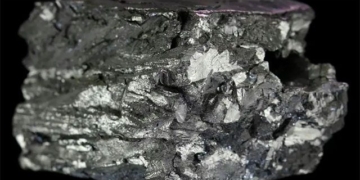Off the northern coast of Canada, a group of scientists is closely monitoring the process of pumping seawater onto the surface of sea ice. Their goal is to mitigate the effects of global warming.
What is Sea Ice?
According to the National Oceanic and Atmospheric Administration (NOAA), sea ice is frozen water that forms and melts on the ocean. It is distinct from icebergs, glaciers, and ice shelves which originate from land. Sea ice typically expands during the winter months and melts in the summer, but in certain regions, it can persist year-round. Approximately 15% of the world’s oceans are covered by sea ice at some point during the year.

Pumping seawater onto sea ice. (Photo: Real Ice).
Although sea ice primarily exists in polar regions, it has a significant impact on the global climate. Gradually warming temperatures are causing sea ice to melt over time, leading to darker ocean surfaces that absorb more sunlight, resulting in rising ocean temperatures. This creates a cycle of warming and melting. Warmer water temperatures slow the formation of ice during the fall and winter while ice melts more rapidly in the subsequent spring, exposing darker ocean waters for longer periods during the following summer.
Changes in sea ice extent can disrupt ocean currents, leading to global climate change. Even small increases in temperature can make polar regions the most sensitive areas to climate change. Therefore, researchers aim to thicken sea ice to prevent it from melting.
Ambitious Plan
Many scientists have strongly opposed this initiative, warning that the method of pumping water onto the surface of sea ice distracts from the critical step of reducing carbon emissions. However, a small group of supporters asserts that their approach could benefit the planet while humanity works to reduce carbon emissions.
Dr. Shaun Fitzgerald, who is involved in the sea ice thickening project at the Cambridge Climate Recovery Center in the UK, states that the ultimate goal of this Arctic experiment is to thicken sea ice enough to slow down or even reverse the melting process. The BBC has reported that some consider this plan to be “madness.”
Dr. Fitzgerald acknowledges: “We really don’t have enough data to determine whether this is a brilliant idea or a bad one.” Researchers have braved the harsh conditions in Cambridge Bay, a small village in Canada located within the Arctic Circle, to carry out the experiment.
Andrea Ceccolini, an employee of Real Ice (UK), shared during the expedition: “It’s quite cold. The temperature is around -30C, and strong winds can drop it to -45C.”
They drill a hole in the naturally formed sea ice during winter and pump about 1,000 liters of seawater per minute onto its surface. Exposed to the freezing winter air, the seawater quickly freezes, helping to thicken the upper layer of the sea ice.
Ceccolini explains: “The idea is that the thicker the ice is at the end of winter, the longer it will last into the melting season.”
They recorded an increase in ice thickness of several dozen centimeters in the small research area. The sea ice will be monitored by local residents in the coming months.
However, it is still too early to assess whether this approach by the scientists will truly make a difference in the rapid decline of Arctic sea ice. Martin Siegert from the University of Exeter (UK), who is not involved in the project, warns: “The vast majority of polar scientists believe this will never succeed.”

Seawater will freeze after being pumped onto sea ice. (Photo: Real Ice).
The issue lies in the characteristics of ice with a higher salt concentration, which may melt faster in the summer. There is also a significant logistical challenge in scaling up the project. It is estimated that around 10 million wind-powered pumps would be needed to thicken sea ice over an area equivalent to one-tenth of the Arctic.
Professor Julienne Stroeve at University College London analyzes: “In my view, it’s madness to think this can be done on a large scale for the entire Arctic Ocean.”
Lili Fuhr, director of the Fossil Economy Program at the Center for International Environmental Law, explains: “Geotechnical technology comes with many uncertainties and creates new risks for ecosystems as well as humans. The Arctic plays a crucial role in maintaining our planet’s system. Pumping seawater onto the surface of sea ice on a large scale could alter the chemical composition of the oceans and threaten fragile life networks.”
There is also a broader concern shared with such projects. Professor Siegert warns that the real danger is distraction, and many will use it as an excuse to continue burning fossil fuels. He adds: “Honestly, it’s madness, and it needs to be stopped. The way to address this crisis is carbon removal: that’s our best and only path forward.”
The researchers in Dr. Fitzgerald’s team are well aware of these concerns. They emphasize that they are only experimenting with the technology and will not apply it more broadly until they better understand the risks. Dr. Fitzgerald stresses: “We are not promoting this as a solution to climate change in the Arctic. We want to say that it could be part of the solution, but we need to learn much more before society can decide whether it is reasonable or not.”
They also agree that geotechnical solutions are not the only measures to address climate change, and drastically reducing fossil fuels and carbon emissions is essential to avoid the dire consequences of global warming. However, they point out that even with prompt action, the world still faces a challenging future. By 2050, the Arctic may well experience a complete loss of sea ice by the end of summer, potentially even sooner. It has undergone significant sea ice reduction since the 1980s.
Researcher Jacob Pantling at the Climate Recovery Center argues: “We need other solutions. Emissions need to be reduced, but even if we do that as soon as possible, the Arctic will still melt.”


















































